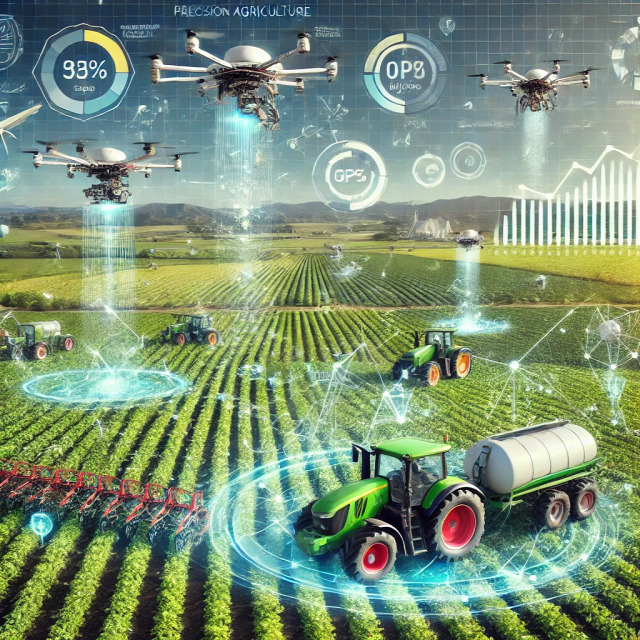
The agriculture industry is undergoing a technological revolution with the rise of precision agriculture, a cutting-edge approach that leverages advanced tools to optimize farming practices. Precision agriculture is not just transforming the way food is produced but is also contributing to sustainable farming and enhanced productivity, addressing the challenges of growing global food demand and environmental conservation.
What is Precision Agriculture?
Precision Agriculture, also known as smart farming, involves using advanced technologies such as sensors, GPS, drones, data analytics, and artificial intelligence to monitor and manage agricultural processes. These technologies enable farmers to make data-driven decisions to optimize inputs like water, fertilizers, and pesticides, ensuring efficient use of resources.
Market Insights: The Growth of Precision Agriculture
The global precision agriculture market was valued at $9,591.8 million in 2023, and it is expected to grow at a CAGR of 15.71% to reach $41,265.0 million by 2033 during the forecast period of 2023-2033.
Key Market Drivers:
- Rising Global Food Demand: The need to produce more food with limited resources is accelerating the adoption of precision farming technologies.
- Technological Advancements: Innovations in AI, machine learning, and IoT are making precision agriculture more accessible and effective
- Government Initiatives: Policies promoting sustainable farming and providing subsidies for technology adoption are boosting market growth.
Key Components of Precision Agriculture
GPS and GIS Technology:
- Enables real-time tracking of equipment and mapping of fields for precise input application.
- Reduces overlap and waste, saving time and resources.
Remote Sensing and IoT Devices:
- Sensors monitor soil moisture, nutrient levels, and weather conditions.
- IoT devices provide actionable insights for irrigation and crop management.
Drones and Robotics:
- Drones offer aerial imagery for crop health assessment and pest detection.
- Robots automate tasks such as planting, weeding, and harvesting.
Data Analytics and AI:
- Advanced algorithms analyze large datasets to predict yields, optimize planting schedules, and detect diseases early.
- Machine learning models improve decision-making over time.
Request for sample research report on the global precision agriculture market
How Precision Agriculture Enhances Sustainability
Efficient Resource Use: Precision agriculture minimizes water, fertilizer, and pesticide usage by applying them only where needed. For example, variable rate technology (VRT) ensures precise application, reducing runoff and environmental pollution.
Soil Health Management: Soil sensors provide detailed information on nutrient levels, allowing farmers to implement targeted soil management practices that preserve fertility and prevent degradation.
Reduction in Carbon Footprint: Smart farming reduces fuel consumption and greenhouse gas emissions by optimizing machinery usage and adopting sustainable practices.
Water Conservation: Precision irrigation systems, such as drip and sprinkler systems integrated with IoT sensors, ensure that crops receive the exact amount of water required, reducing wastage.
Boosting Productivity Through Precision Agriculture
Increased Crop Yields: By providing real-time insights into crop health, soil conditions, and weather patterns, precision agriculture helps farmers take proactive measures to increase yields.
Reduced Costs: Efficient use of inputs like seeds, water, and fertilizers reduces operational costs while improving profitability.
Disease and Pest Management: Early detection of diseases and pests using drones and sensors prevents widespread damage, protecting crops and reducing the need for chemical treatments.
Precision Agriculture Market Segmentation
Segmentation by Application:
- Crop Monitoring
- Precision Planting
- Precision Spraying
- Precision Fertilization
- Precision Irrigation
- Farm Management
- Others
Segmentation by Technology:
- Guidance Technology
- Sensing Technology
- Variable Rate Application
- Data Analytics and Intelligence
- Others
Segmentation by Region:
- North America
- Europe
- Asia-Pacific
- Middle East and Africa
- China
- U.K.
- Rest of the World
Get more insights on the Agriculture Market Research Reports.
The Future of Precision Agriculture
The future of precision agriculture is promising, with advancements such as autonomous farming equipment, AI-powered decision-making tools, and blockchain for supply chain transparency set to redefine the industry.
Key trends to watch:
- Integration with Renewable Energy: Solar-powered devices and energy-efficient systems will enhance sustainability.
- Micro-Level Precision: Nano-sensors and micro-robots will enable even more accurate monitoring and management.
- Global Collaboration: Partnerships between governments, tech companies, and farmers will drive innovation and accessibility.
Conclusion
Precision agriculture is revolutionizing the farming landscape by blending technology with sustainability. Its ability to optimize resource use, enhance productivity, and reduce environmental impact makes it a cornerstone of modern agriculture.
As the global precision agriculture industry continues to grow, farmers and industry stakeholders must embrace innovation and collaboration to build a resilient and sustainable food system for the future.

